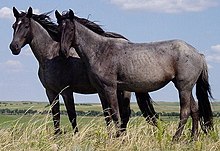
Back Guda ACE Perd Afrikaans Hauspferd ALS Ат ALT ፈረስ Amharic Equus caballus AN Hors ANG घोड़ा ANP فرس Arabic ܣܘܣܝܐ ARC
| Horse | |
|---|---|

| |
Domesticated
| |
| Scientific classification | |
| Domain: | Eukaryota |
| Kingdom: | Animalia |
| Phylum: | Chordata |
| Class: | Mammalia |
| Order: | Perissodactyla |
| Family: | Equidae |
| Genus: | Equus |
| Species: | |
| Subspecies: | E. f. caballus
|
| Trinomial name | |
| Equus ferus caballus | |
| Synonyms[2] | |
|
at least 48 published | |

Horses are a group of animals of the family Equidae. They are herbivores, which means they eat grass and other plants. Some plants are dangerous for them, like ragwort, lemongrass (oil grass) and sometimes acorns.[3]
The standard horse is the species Equus caballus. It was domesticated from wild horses by humans at least 5000 years ago. They are large, strong animals and some breeds are used to pull heavy loads. Racehorses can gallop up to 30 miles an hour.
A male horse is a stallion, and a female horse is a mare, while the general term for a young horse is a foal. A young female horse is a filly, and a young male horse is a colt. A castrated horse is a gelding. Horses have hooves which sometimes have protection called horseshoes from hard or rough ground.
Horses are related to the rhino and tapir in the order Perissodactyla.[4]
- ↑ Linnaeus, Carolus (1758). Systema naturae per regna tria naturae :secundum classes, ordines, genera, species, cum characteribus, differentiis, synonymis, locis. Vol. 1 (10th ed.). Holmiae (Laurentii Salvii). p. 73. Retrieved 2008-09-08.
- ↑ Grubb, P. (2005). "Order Perissodactyla". In Wilson, D.E.; Reeder, D.M (eds.). Mammal Species of the World: A Taxonomic and Geographic Reference (3rd ed.). Johns Hopkins University Press. pp. 630–631. ISBN 978-0-8018-8221-0. OCLC 62265494.
- ↑ "Plants Poisonous To Horses | The British Horse Society". www.bhs.org.uk. Retrieved 2024-11-16.
- ↑ "What Horses and Rhinos Have in Common: An Ancestor in India". NBC News. 2014-11-20. Retrieved 2024-11-16.